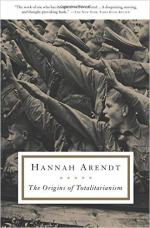|
This section contains 1,235 words (approx. 4 pages at 400 words per page) |

|
Summary
Arendt defines “ideology” as an "-ism" according to which everything can be explained from a single premise. (Marxism is the view that class conflict can explain all of history) Ideologies are a recent phenomenon, and for a long time, played no role in politics, since the members of the ruling classes had common interests, and had no need to motivate the masses. Hitler and Stalin discovered the power of ideology.
Ideologies pretend to be scientifically grounded. The very word suggests that an idea can be the object of a science (logos: thus, "ideo-logy"), the way that animals are the object of zoology. Does that mean that ideologies are scientific statements about the realm of ideas, the way that zoology is a set of scientific propositions about animals?
No. Ideologies are more than this. They aim for a totality that a science like zoology...
(read more from the Part Three Summary)
|
This section contains 1,235 words (approx. 4 pages at 400 words per page) |

|




